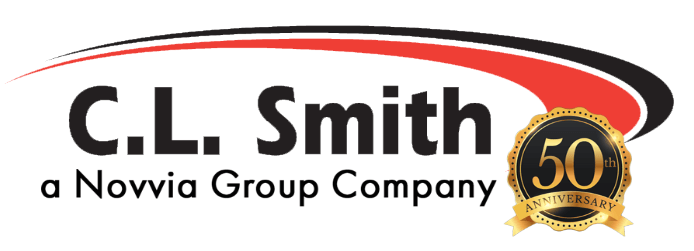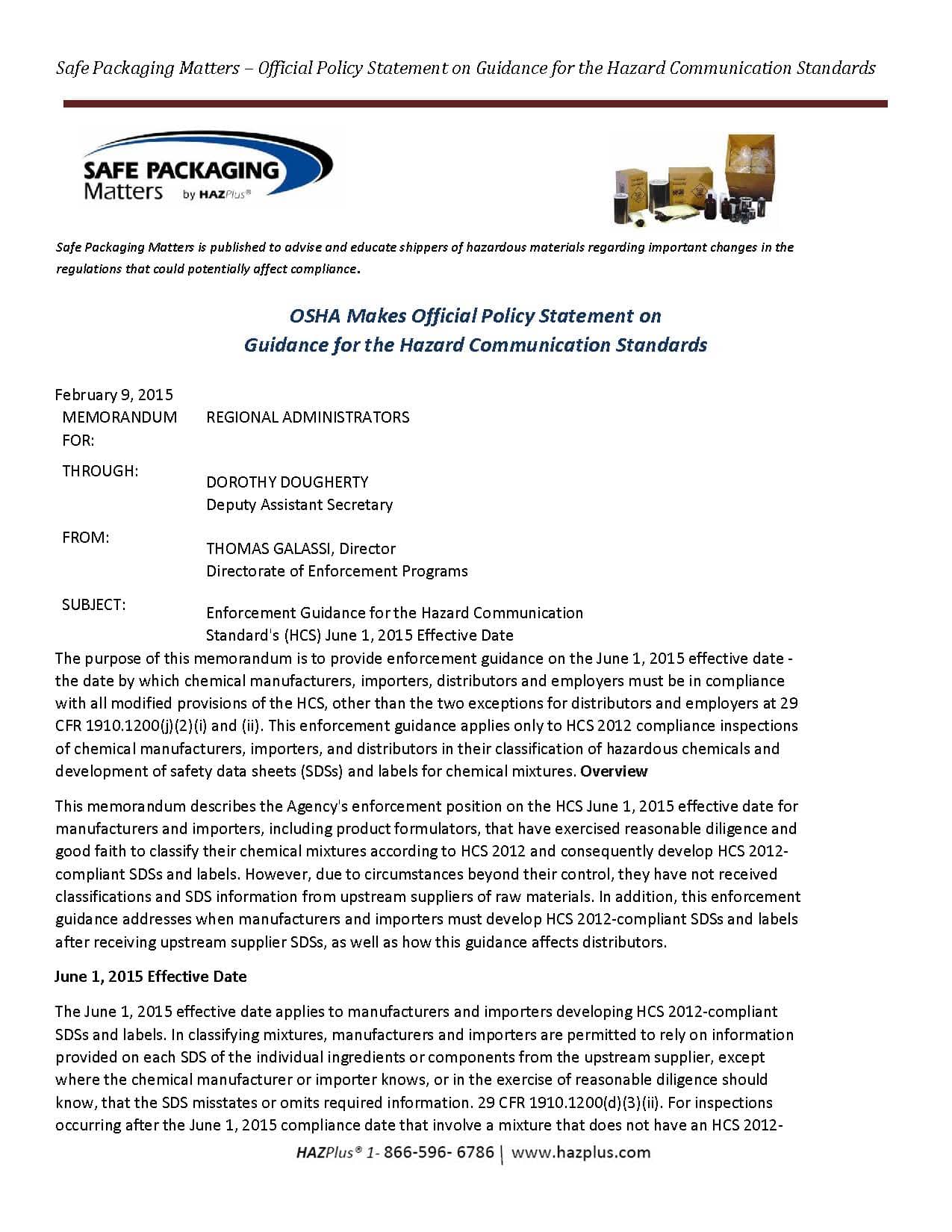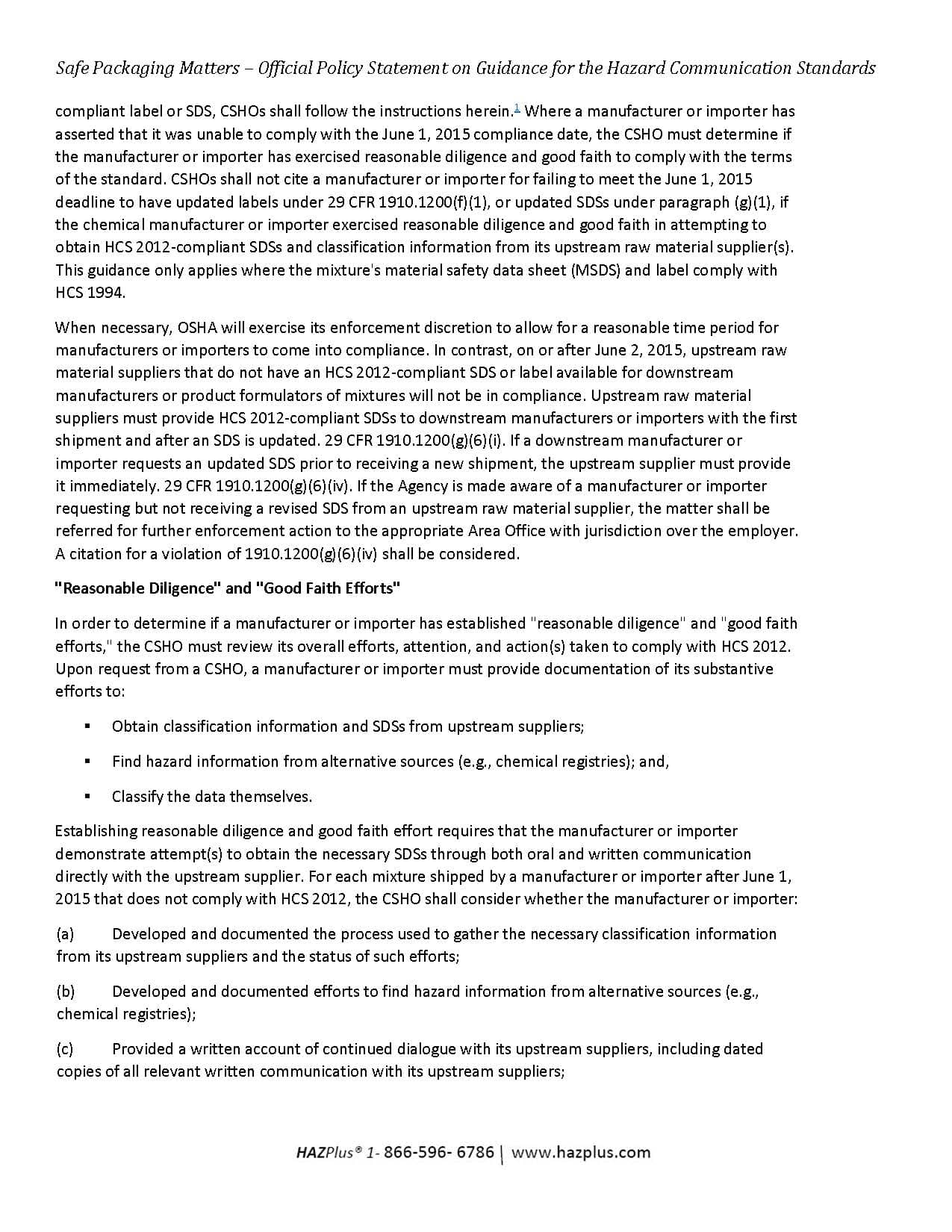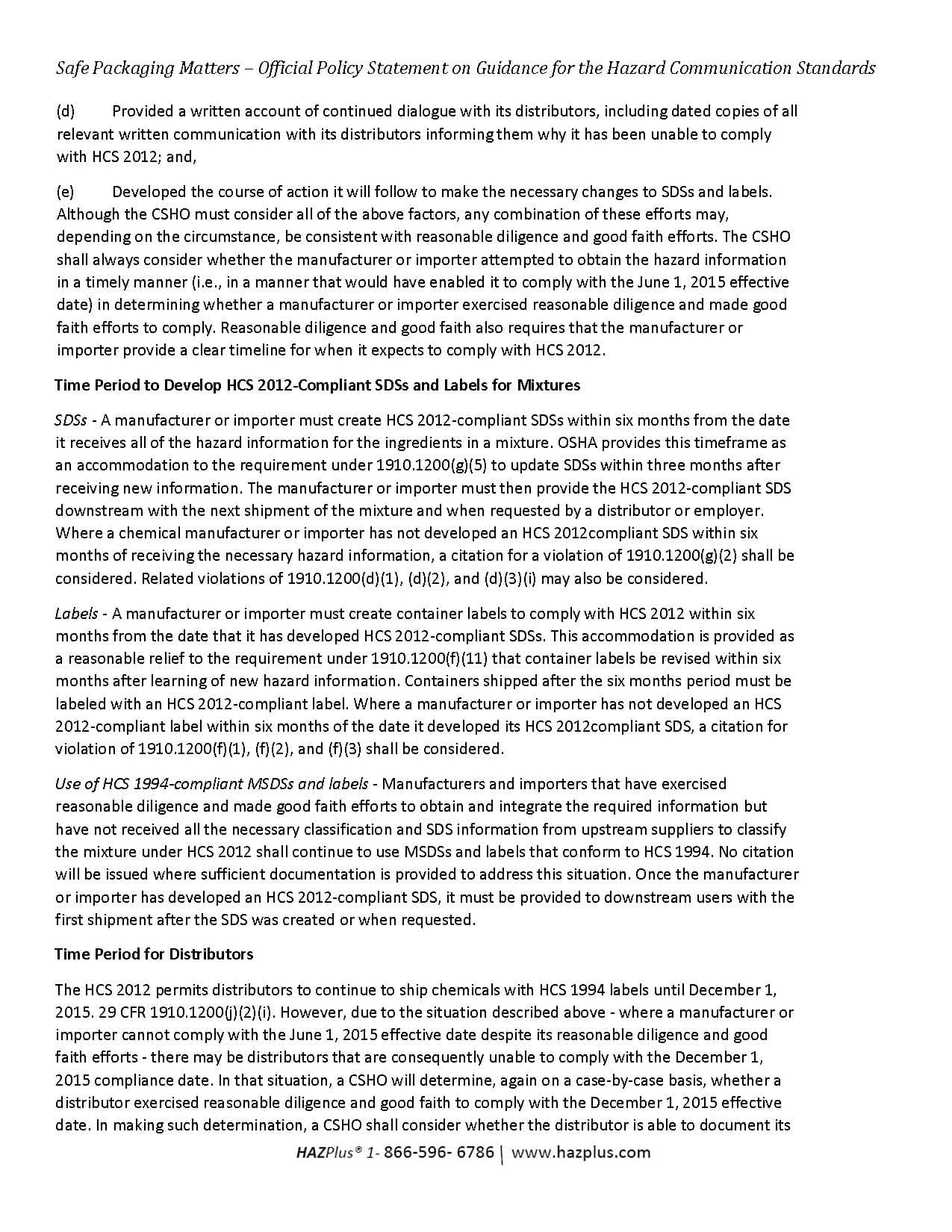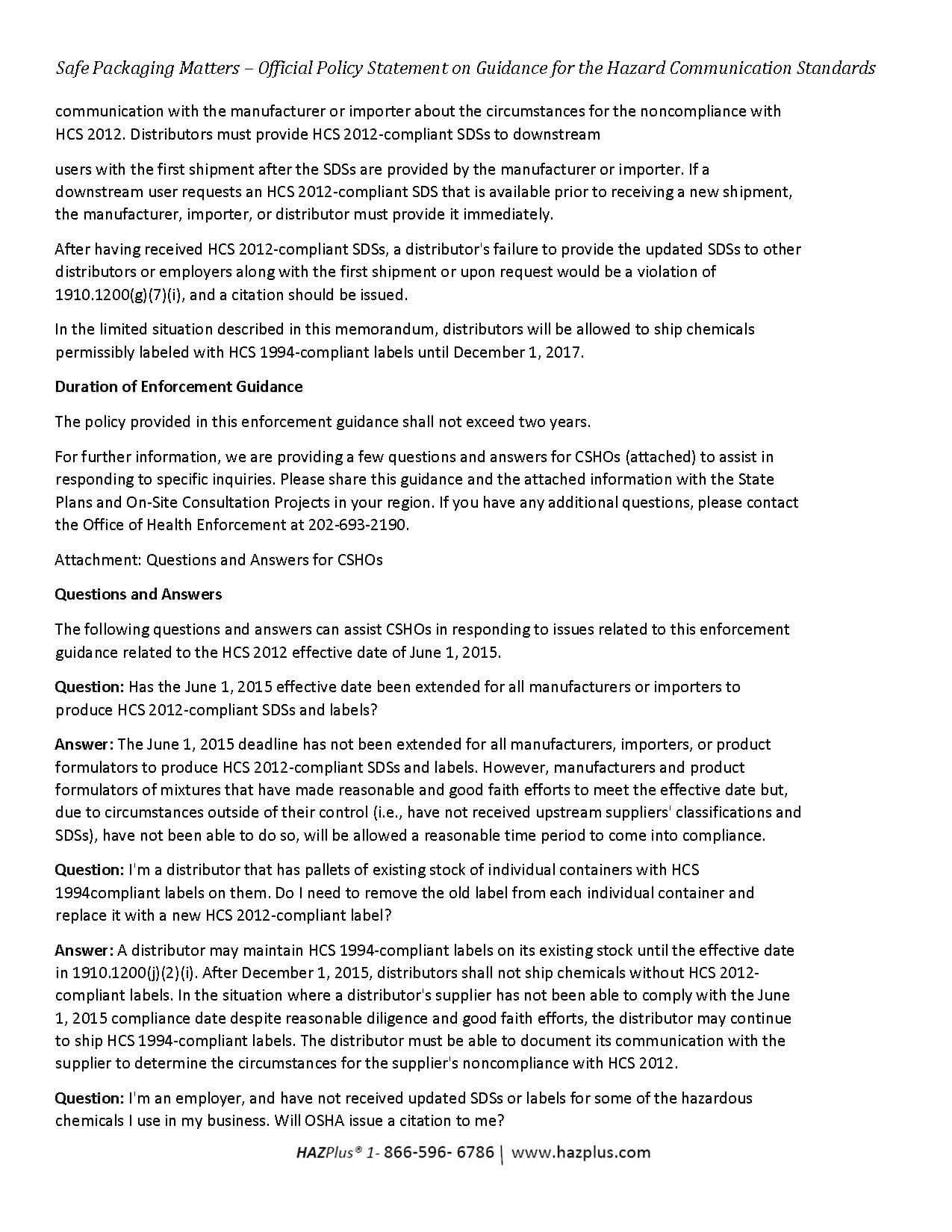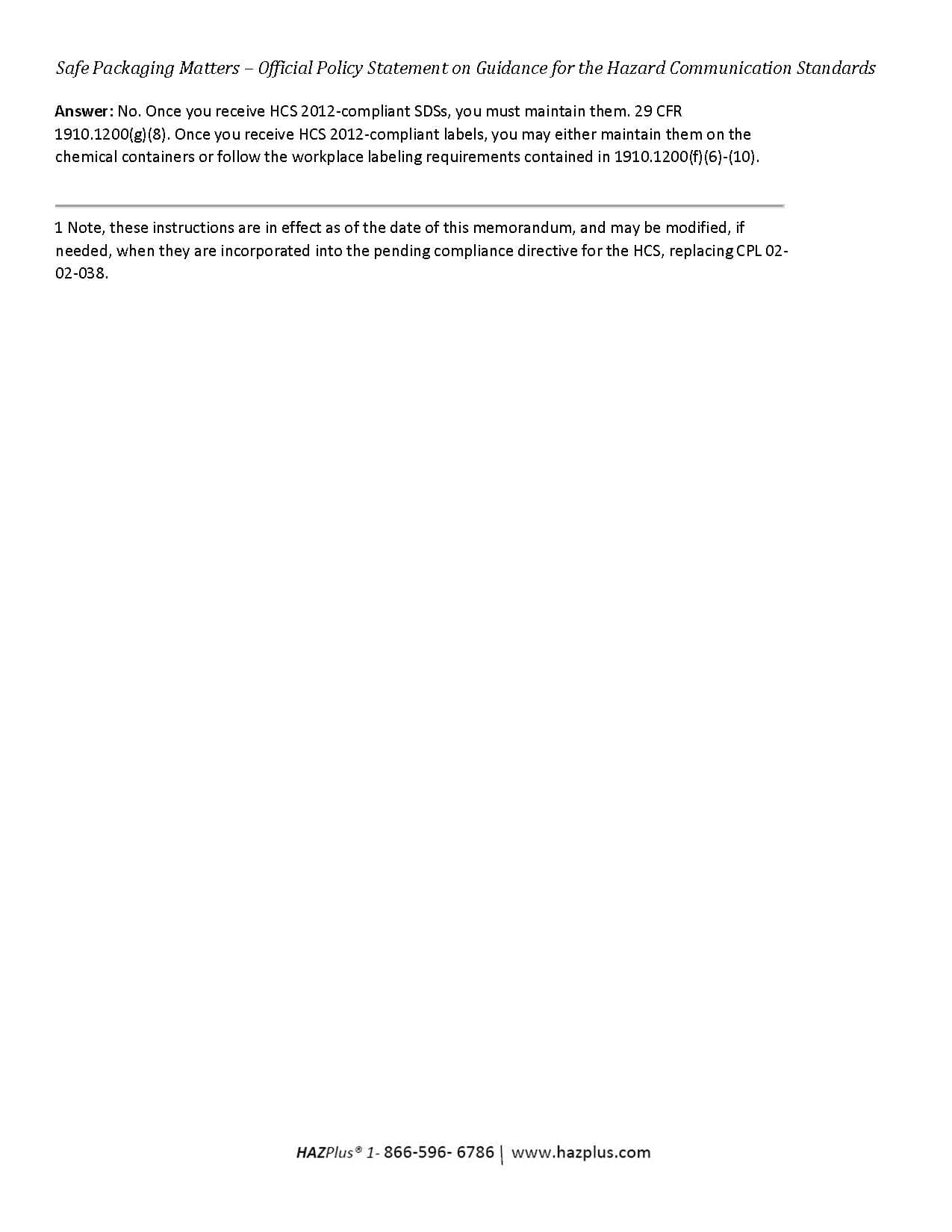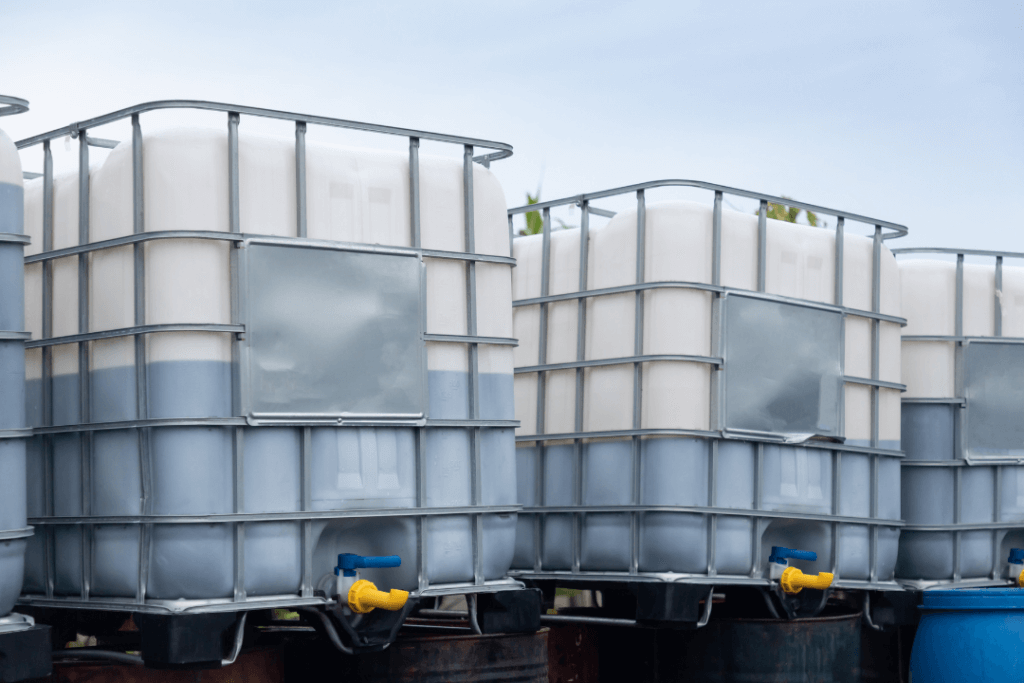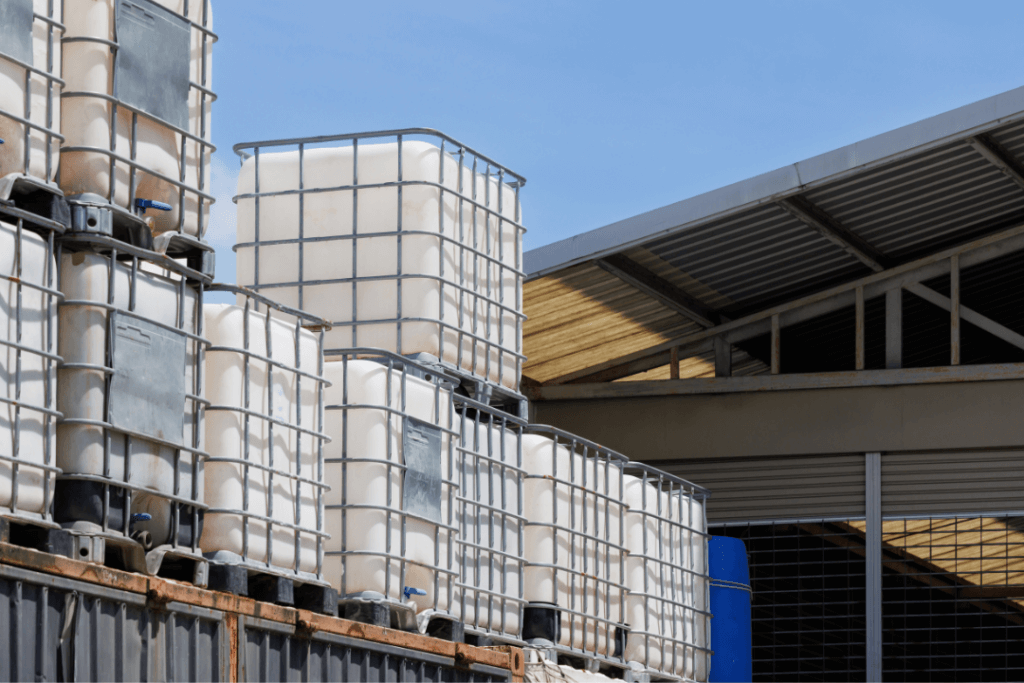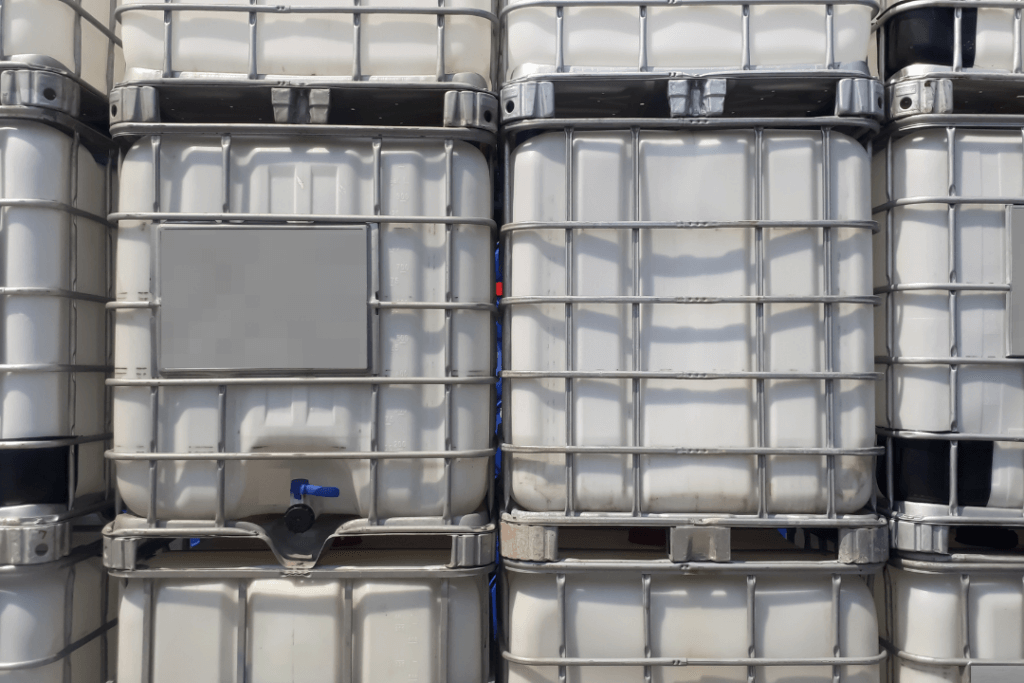OSHA Makes Official Policy Statement on
Guidance for the Hazard Communication Standards
February 9, 2015
| MEMORANDUMFOR: | REGIONAL ADMINISTRATORS |
| THROUGH: | DOROTHY DOUGHERTYDeputy Assistant Secretary |
| FROM: | THOMAS GALASSI, DirectorDirectorate of Enforcement Programs |
| SUBJECT: | Enforcement Guidance for the Hazard Communication Standard’s (HCS) June 1, 2015 Effective Date |
The purpose of this memorandum is to provide enforcement guidance on the June 1, 2015 effective date ‐ the date by which chemical manufacturers, importers, distributors and employers must be in compliance with all modified provisions of the HCS, other than the two exceptions for distributors and employers at 29 CFR 1910.1200(j)(2)(i) and (ii). This enforcement guidance applies only to HCS 2012 compliance inspections of chemical manufacturers, importers, and distributors in their classification of hazardous chemicals and development of safety data sheets (SDSs) and labels for chemical mixtures. Overview
This memorandum describes the Agency’s enforcement position on the HCS June 1, 2015 effective date for manufacturers and importers, including product formulators, that have exercised reasonable diligence and good faith to classify their chemical mixtures according to HCS 2012 and consequently develop HCS 2012‐compliant SDSs and labels. However, due to circumstances beyond their control, they have not received classifications and SDS information from upstream suppliers of raw materials. In addition, this enforcement guidance addresses when manufacturers and importers must develop HCS 2012‐compliant SDSs and labels after receiving upstream supplier SDSs, as well as how this guidance affects distributors.
June 1, 2015 Effective Date
The June 1, 2015 effective date applies to manufacturers and importers developing HCS 2012‐compliant SDSs and labels. In classifying mixtures, manufacturers and importers are permitted to rely on information provided on each SDS of the individual ingredients or components from the upstream supplier, except where the chemical manufacturer or importer knows, or in the exercise of reasonable diligence should know, that the SDS misstates or omits required information. 29 CFR 1910.1200(d)(3)(ii). For inspections occurring after the June 1, 2015 compliance date that involve a mixture that does not have an HCS 2012‐compliant label or SDS, CSHOs shall follow the instructions herein.1 Where a manufacturer or importer has asserted that it was unable to comply with the June 1, 2015 compliance date, the CSHO must determine if the manufacturer or importer has exercised reasonable diligence and good faith to comply with the terms of the standard. CSHOs shall not cite a manufacturer or importer for failing to meet the June 1, 2015 deadline to have updated labels under 29 CFR 1910.1200(f)(1), or updated SDSs under paragraph (g)(1), if the chemical manufacturer or importer exercised reasonable diligence and good faith in attempting to obtain HCS 2012‐compliant SDSs and classification information from its upstream raw material supplier(s). This guidance only applies where the mixture’s material safety data sheet (MSDS) and label comply with HCS 1994.
When necessary, OSHA will exercise its enforcement discretion to allow for a reasonable time period for manufacturers or importers to come into compliance. In contrast, on or after June 2, 2015, upstream raw material suppliers that do not have an HCS 2012‐compliant SDS or label available for downstream manufacturers or product formulators of mixtures will not be in compliance. Upstream raw material suppliers must provide HCS 2012‐compliant SDSs to downstream manufacturers or importers with the first shipment and after an SDS is updated. 29 CFR 1910.1200(g)(6)(i). If a downstream manufacturer or importer requests an updated SDS prior to receiving a new shipment, the upstream supplier must provide it immediately. 29 CFR 1910.1200(g)(6)(iv). If the Agency is made aware of a manufacturer or importer requesting but not receiving a revised SDS from an upstream raw material supplier, the matter shall be referred for further enforcement action to the appropriate Area Office with jurisdiction over the employer. A citation for a violation of 1910.1200(g)(6)(iv) shall be considered.
“Reasonable Diligence” and “Good Faith Efforts”
In order to determine if a manufacturer or importer has established “reasonable diligence” and “good faith efforts,” the CSHO must review its overall efforts, attention, and action(s) taken to comply with HCS 2012. Upon request from a CSHO, a manufacturer or importer must provide documentation of its substantive efforts to:
- Obtain classification information and SDSs from upstream suppliers;
- Find hazard information from alternative sources (e.g., chemical registries); and,
- Classify the data themselves.
Establishing reasonable diligence and good faith effort requires that the manufacturer or importer demonstrate attempt(s) to obtain the necessary SDSs through both oral and written communication directly with the upstream supplier. For each mixture shipped by a manufacturer or importer after June 1, 2015 that does not comply with HCS 2012, the CSHO shall consider whether the manufacturer or importer:
- Developed and documented the process used to gather the necessary classification information from its upstream suppliers and the status of such efforts;
- Developed and documented efforts to find hazard information from alternative sources (e.g., chemical registries);
- Provided a written account of continued dialogue with its upstream suppliers, including dated copies of all relevant written communication with its upstream suppliers;
- Provided a written account of continued dialogue with its distributors, including dated copies of all relevant written communication with its distributors informing them why it has been unable to comply with HCS 2012; and,
- Developed the course of action it will follow to make the necessary changes to SDSs and labels. Although the CSHO must consider all of the above factors, any combination of these efforts may, depending on the circumstance, be consistent with reasonable diligence and good faith efforts. The CSHO shall always consider whether the manufacturer or importer attempted to obtain the hazard information in a timely manner (i.e., in a manner that would have enabled it to comply with the June 1, 2015 effective date) in determining whether a manufacturer or importer exercised reasonable diligence and made good faith efforts to comply. Reasonable diligence and good faith also requires that the manufacturer or importer provide a clear timeline for when it expects to comply with HCS 2012.
Time Period to Develop HCS 2012‐Compliant SDSs and Labels for Mixtures
SDSs ‐ A manufacturer or importer must create HCS 2012‐compliant SDSs within six months from the date it receives all of the hazard information for the ingredients in a mixture. OSHA provides this timeframe as an accommodation to the requirement under 1910.1200(g)(5) to update SDSs within three months after receiving new information. The manufacturer or importer must then provide the HCS 2012‐compliant SDS downstream with the next shipment of the mixture and when requested by a distributor or employer. Where a chemical manufacturer or importer has not developed an HCS 2012compliant SDS within six months of receiving the necessary hazard information, a citation for a violation of 1910.1200(g)(2) shall be considered. Related violations of 1910.1200(d)(1), (d)(2), and (d)(3)(i) may also be considered.
Labels ‐ A manufacturer or importer must create container labels to comply with HCS 2012 within six months from the date that it has developed HCS 2012‐compliant SDSs. This accommodation is provided as a reasonable relief to the requirement under 1910.1200(f)(11) that container labels be revised within six months after learning of new hazard information. Containers shipped after the six months period must be labeled with an HCS 2012‐compliant label. Where a manufacturer or importer has not developed an HCS 2012‐compliant label within six months of the date it developed its HCS 2012compliant SDS, a citation for violation of 1910.1200(f)(1), (f)(2), and (f)(3) shall be considered.
Use of HCS 1994‐compliant MSDSs and labels ‐ Manufacturers and importers that have exercised reasonable diligence and made good faith efforts to obtain and integrate the required information but have not received all the necessary classification and SDS information from upstream suppliers to classify the mixture under HCS 2012 shall continue to use MSDSs and labels that conform to HCS 1994. No citation will be issued where sufficient documentation is provided to address this situation. Once the manufacturer or importer has developed an HCS 2012‐compliant SDS, it must be provided to downstream users with the first shipment after the SDS was created or when requested.
Time Period for Distributors
The HCS 2012 permits distributors to continue to ship chemicals with HCS 1994 labels until December 1, 2015. 29 CFR 1910.1200(j)(2)(i). However, due to the situation described above ‐ where a manufacturer or importer cannot comply with the June 1, 2015 effective date despite its reasonable diligence and good faith efforts ‐ there may be distributors that are consequently unable to comply with the December 1, 2015 compliance date. In that situation, a CSHO will determine, again on a case‐by‐case basis, whether a distributor exercised reasonable diligence and good faith to comply with the December 1, 2015 effective date. In making such determination, a CSHO shall consider whether the distributor is able to document its communication with the manufacturer or importer about the circumstances for the noncompliance with HCS 2012. Distributors must provide HCS 2012‐compliant SDSs to downstream
users with the first shipment after the SDSs are provided by the manufacturer or importer. If a downstream user requests an HCS 2012‐compliant SDS that is available prior to receiving a new shipment, the manufacturer, importer, or distributor must provide it immediately.
After having received HCS 2012‐compliant SDSs, a distributor’s failure to provide the updated SDSs to other distributors or employers along with the first shipment or upon request would be a violation of 1910.1200(g)(7)(i), and a citation should be issued.
In the limited situation described in this memorandum, distributors will be allowed to ship chemicals permissibly labeled with HCS 1994‐compliant labels until December 1, 2017.
Duration of Enforcement Guidance
The policy provided in this enforcement guidance shall not exceed two years.
For further information, we are providing a few questions and answers for CSHOs (attached) to assist in responding to specific inquiries. Please share this guidance and the attached information with the State Plans and On‐Site Consultation Projects in your region. If you have any additional questions, please contact the Office of Health Enforcement at 202‐693‐2190.
Attachment: Questions and Answers for CSHOs
Questions and Answers
The following questions and answers can assist CSHOs in responding to issues related to this enforcement guidance related to the HCS 2012 effective date of June 1, 2015.
Question: Has the June 1, 2015 effective date been extended for all manufacturers or importers to produce HCS 2012‐compliant SDSs and labels?
Answer: The June 1, 2015 deadline has not been extended for all manufacturers, importers, or product formulators to produce HCS 2012‐compliant SDSs and labels. However, manufacturers and product formulators of mixtures that have made reasonable and good faith efforts to meet the effective date but, due to circumstances outside of their control (i.e., have not received upstream suppliers’ classifications and SDSs), have not been able to do so, will be allowed a reasonable time period to come into compliance.
Question: I’m a distributor that has pallets of existing stock of individual containers with HCS 1994compliant labels on them. Do I need to remove the old label from each individual container and replace it with a new HCS 2012‐compliant label?
Answer: A distributor may maintain HCS 1994‐compliant labels on its existing stock until the effective date in 1910.1200(j)(2)(i). After December 1, 2015, distributors shall not ship chemicals without HCS 2012‐compliant labels. In the situation where a distributor’s supplier has not been able to comply with the June 1, 2015 compliance date despite reasonable diligence and good faith efforts, the distributor may continue to ship HCS 1994‐compliant labels. The distributor must be able to document its communication with the supplier to determine the circumstances for the supplier’s noncompliance with HCS 2012.
Question: I’m an employer, and have not received updated SDSs or labels for some of the hazardous chemicals I use in my business. Will OSHA issue a citation to me?
Answer: No. Once you receive HCS 2012‐compliant SDSs, you must maintain them. 29 CFR
1910.1200(g)(8). Once you receive HCS 2012‐compliant labels, you may either maintain them on the chemical containers or follow the workplace labeling requirements contained in 1910.1200(f)(6)‐(10).
1 Note, these instructions are in effect as of the date of this memorandum, and may be modified, if needed, when they are incorporated into the pending compliance directive for the HCS, replacing CPL 02‐02‐038.
About the Publication: Safe Packaging Matters is published to advise and educate shippers of hazardous materials regarding important changes in the regulations that could potentially affect compliance. HAZPlus® is the division of the C.L. Smith Company that designs, manufactures, tests and certifies hazardous materials packaging for safe transport.
Safe Packaging Matters – OSHA Enforcement Guidance on the June 1, 2015
Comments are closed
